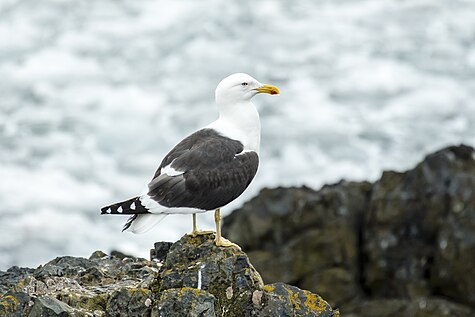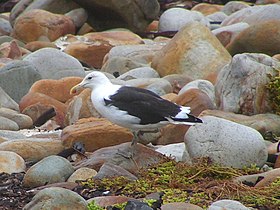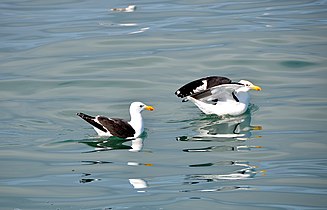Kelp gull
| Kelp gull | |
|---|---|
| Adult in Livingston Island, South Shetland Islands | |
| Scientific classification | |
| Domain: | Eukaryota |
| Kingdom: | Animalia |
| Phylum: | Chordata |
| Class: | Aves |
| Order: | Charadriiformes |
| Family: | Laridae |
| Genus: | Larus |
| Species: | L. dominicanus
|
| Binomial name | |
| Larus dominicanus Lichtenstein, MHC, 1823
| |

| |
The kelp gull (Larus dominicanus), also known as the Dominican gull, is a gull that breeds on coasts and islands through much of the Southern Hemisphere. The nominate L. d. dominicanus is the subspecies found around South America, parts of Australia (where it overlaps with the Pacific gull), and New Zealand (where it is known as the black-backed gull, the southern black-backed gull, mollyhawk[2] – particularly the juveniles,[3] or by its Māori name karoro). L. d. vetula (known as the Cape gull) is a subspecies occurring around Southern Africa.
The specific name comes from the Dominican Order of friars, who wear black and white habits.[4]
Description
[edit]The kelp gull superficially resembles two gulls from further north in the Atlantic Ocean, the lesser black-backed gull and the great black-backed gull, and is intermediate in size between these two species. This species ranges from 54 to 65 cm (21 to 26 in) in total length, from 128 to 142 cm (50 to 56 in) in wingspan and from 540 to 1,390 g (1.19 to 3.06 lb) in weight. Adult males and females weigh on average 1,000 g (2.2 lb) and 900 g (2.0 lb) respectively. Among standard measurements, the wing chord is 37.3 to 44.8 cm (14.7 to 17.6 in), the bill is 4.4 to 5.9 cm (1.7 to 2.3 in) and the tarsus is 5.3 to 7.5 cm (2.1 to 3.0 in).[5][6][7] The adult kelp gull has black upper parts and wings. The head, underparts, tail, and the small "mirrors" at the wing tips are white. The bill is yellow with a red spot, and the legs are greenish-yellow (brighter and yellower when breeding, duller and greener when not breeding). The call is a strident ki-och. Juveniles have dull legs, a black bill, a dark band in the tail, and an overall grey-brown plumage densely edged whitish, but they rapidly get a pale base to the bill and largely white head and underparts. They take three or four years to reach maturity.
Subspecies
[edit]There are five subspecies of kelp gull. The African subspecies L. d. vetula is sometimes split as the Cape gull, L. vetula. It has a more angular head and a smaller shorter bill. The adult has a dark eye, whereas the nominate kelp gull usually has a pale eye. Young Cape gulls have almost identical plumage to similarly aged kelp gulls.
- L. d. dominicanus, (Lichtenstein, 1823): South America, Falklands, South Georgia, Australia & New Zealand
- L. d. vetula, (Bruch, 1853): Southern Africa
- L. d. judithae, (Jiguet, 2002): subantarctic islands in the Indian Ocean
- L. d. melisandae, (Jiguet, 2002): southern & southwestern Madagascar
- L. d. austrinus, (Fleming, 1924): Antarctica & Antarctic islands
The kelp gull is a rare vagrant to the United States, with the first record in 1989 on Chandeleur Islands in Louisiana. They have interbred with American herring gull on these islands, leading to intermediate birds that may backcross to one another. After Hurricane Katrina in 2005, breeding populations of the two species and their hybrids were displaced from the island, though putative hybrids have been reported elsewhere and may be the result of other offshore colonies. [8]
Behaviour
[edit]Kelp gulls are omnivores like most Larus gulls, and they will scavenge as well as seek suitable small prey. They gather on landfills and a sharp increase in population is therefore considered as an indicator for a degraded environment.[9] Kelp gulls have been observed feeding on living right whales since at least 1996.[10] The kelp gull uses its powerful beak to peck down centimetres into the skin and blubber, often leaving the whales with large open sores, some of which have been observed to be half a meter in diameter. This predatory behavior has been documented in Argentinian waters.[11] At rocky sites along the Southern African coast, such as at Boulders Beach in Cape Town, kelp gulls (Larus dominicanus vetula) can be seen picking up shellfish and repeatedly flying up several meters and dropping them onto the rocks below in order to break them open.[12] They have also been reported pecking the eyes out of seal pups on the coast of Namibia before attacking the blind seals in a group.[13]
The nest is a shallow depression on the ground lined with vegetation and feathers. The female usually lays 2 or 3 eggs.[14] Both parents feed the young birds.
Gallery
[edit]- Kelp gull
-
At Concón, Chile
-
Adult and two chicks in New Zealand
-
Juvenile in New Zealand
-
Kelp gull in flight
-
Subspecies L. d. dominicanus stealing a meal of shellfish from blackish oystercatchers in Bahía Inglesa, Chile
Cape gull (Larus dominicanus vetula or Larus vetula)
[edit]- Cape gull
-
Cape gull (L. d. vetula), Boulders Beach, South Africa
-
Hout Bay, South Africa
-
Hout Bay, South Africa
-
Cape gulls searching for food in South Africa
The Cape gull differs from other forms of kelp gulls by its darker iris and larger body and bill size. The Southern African population is estimated to include 11,000 breeding pairs, and is expanding.[15]
References
[edit]- ^ BirdLife International (2018). "Larus dominicanus". IUCN Red List of Threatened Species. 2018: e.T22694329A132542863. doi:10.2305/IUCN.UK.2018-2.RLTS.T22694329A132542863.en. Retrieved 12 November 2021.
- ^ "Southern black-backed gull | New Zealand Birds Online".
- ^ "Mollyhawk definition and meaning | Collins English Dictionary".
- ^ "Shelly Farr Biswell", "Southern Black-Backed Gulls", New Zealand Geographic, number 73, May–June 2005
- ^ Gulls: Of North America, Europe, and Asia by Klaus Malling Olsen & Hans Larsson. Princeton University Press (2004). ISBN 978-0691119977.
- ^ Harrison, Peter, Seabirds: An Identification Guide. Houghton Mifflin Harcourt (1991), ISBN 978-0-395-60291-1
- ^ CRC Handbook of Avian Body Masses by John B. Dunning Jr. (Editor). CRC Press (1992), ISBN 978-0-8493-4258-5.
- ^ Ayyash, Amar. "Another Presumed Chandeleur Gull in Indiana". Retrieved 2021-08-23.
- ^ Cf. José Felipe M. Pereira, Aves e Pássaros Comuns do Rio de Janeiro, Rio de Janeiro: Technical Books, ISBN 978-85-61368-00-5, pg.55
- ^ Increased harassment of Right Whales (Eubalaena australis) by Kelp Gulls (Larus dominicanus) at Península Valdés, Argentina. Rowntree, V.J., P. MacGuiness, K. Marshall, R. Payne, J. Seger, and M. Sironi, 1998. Marine Mammal Science. 14(1): 99 - 115. doi:10.1111/j.1748-7692.1998.tb00693.x
- ^ Gulls' vicious attacks on whales. BBC News, June 24, 2009.
- ^ Siegfried WR (1977) Mussel dropping behaviour of Kelp Gulls. S Afr J Sci 73:337 - 341
- ^ Bittel, Jason (17 August 2015). "Seagulls Have a Gruesome New Way of Attacking Baby Seals". National Geographic. Archived from the original on May 16, 2021. Retrieved 4 September 2015.
- ^ "Kelp gull – Australian Antarctic Program". Australian Antarctic Program. 2017-02-16. Retrieved 2024-06-19.
- ^ Underhill, Les; Cooper, John. "Kelp Gull (Larus Dominicanus Vetula) "Cape Gull"". UCT Animal Demography Unit. Retrieved 2020-12-22.
- Ian Sinclair, Phil Hockey and Warwick Tarboton, SASOL Birds of Southern Africa (Struik 2002) ISBN 1-86872-721-1
External links
[edit]- Species text in The Atlas of Southern African Birds
- Kelp gull pictures on jostimages.com
- Specimens of Larus dominicanus in the collection of Museum of New Zealand Te Papa Tongarewa











